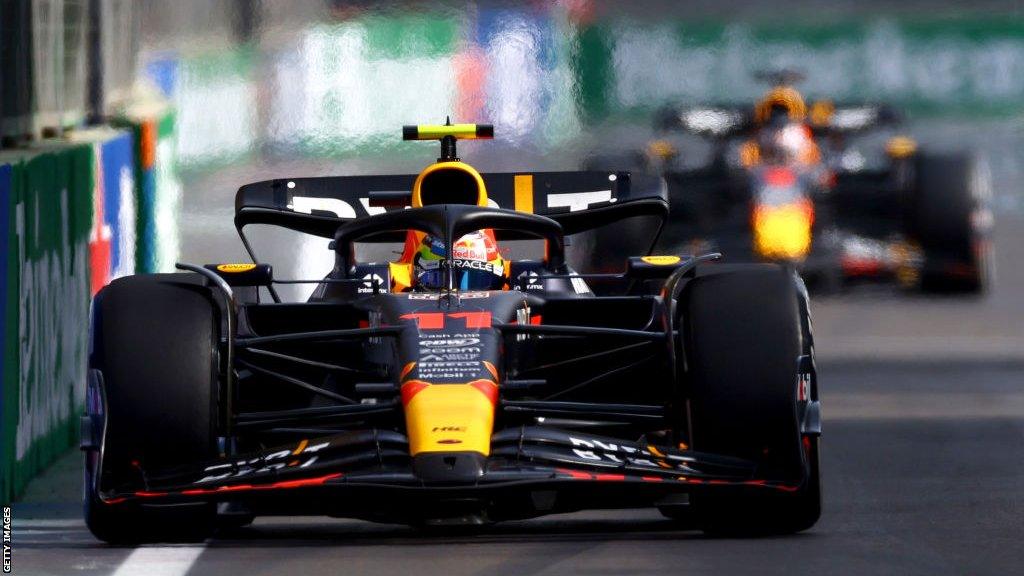Miami Grand Prix: Fernando Alonso says rules should be given time despite lack of entertainment
- Published
- comments

Red Bull's Sergio Perez and Max Verstappen dominated a largely processional Azerbaijan Grand Prix
Fernando Alonso says Formula 1 should give its rules more time before taking action to try to fix the lack of on-track entertainment.
But the two-time world champion added that Red Bull's advantage over the field, the closeness of the rest of the cars and the fragility of tyres were all to blame.
Alonso said: "If Red Bull were not so far ahead, it is a very interesting fight with three or four teams within 0.1-0.2secs. And maybe then we would be saying the rules were a success."
He added: "Maybe this is the story in a few years' time when we have some stability in the rules."
F1 changed its technical rules for the 2022 season to try to bring the field closer together and make overtaking easier.
But although the cars have been able to run closer to each other, Red Bull have dominated and the racing seems little different.
Mercedes team principal Toto Wolff said the sport needed to look into what it can do about the last race in Azerbaijan being "boring".
Alonso was asked whether he felt the new cars - which develop their performance from an underfloor aerodynamic feature known as 'ground effect' - were the right way to go.
"It's a good question," the Aston Martin driver said. "There were higher expectations of following cars and maybe having the grid a little bit closer together, but I think we need to give a little bit more time."
Asked why overtaking seemed harder this year, Alonso said: "I think because we are very close in terms of performance. If you remove the Red Bulls, sometimes there is just six-tenths between third and 16th place in first qualifying.
"Then, eventually you finish qualifying in the order you deserve and then in the race, how will you overtake a car in front of you that is just half a tenth quicker than you? It is your natural order. That is the main reason."
But he also said the propensity of the Pirelli tyres to suffer from overheating when pushed hard or when a driver is following another car was also a factor.
"It could be the tyres as well," Alonso said. "They still get overheated quite heavily if you follow cars. You need to decide wisely when you want to be too close to a car in front of you, so that's the problem."
Ferrari's Carlos Sainz agreed with Alonso's point about tyre overheating, and said the drivers were developing a consensus on the wider issue of the difficulty of close racing and that they should make more effort to engage with F1 and governing body the FIA on the topic.
Sainz was one of several drivers - including Mercedes' George Russell and McLaren's Lando Norris - to question the decision by the FIA to shorten the zone in which drivers can use their DRS overtaking aid in Baku. The same decision has been made for this weekend's Miami Grand Prix.
"To the benefit of F1, and how difficult it is to follow, at least I wouldn't shorten them. I would leave them as they were," Sainz said.
But Alonso said the FIA had made that decision because Baku and Miami were two of the races where overtaking was easiest last year.
And he pointed out that while Mercedes found it hard to overtake in Baku, they were using a higher-downforce set-up than others. And that the Red Bulls could overtake well before the first corner using DRS.
"If you take one car, it was too long, and if you take another, it was too short. So I guess it was about the calculations that the FIA do after seeing last year's races. Baku and Miami were on the high side in terms of overtaking and how easy it was and that's why they shortened it."
World champion Max Verstappen says the stiffness of the ground-effect cars is one of the problems preventing overtaking, because drivers cannot experiment with different lines, over kerbs and so on.
"I would prefer if we could race without DRS but that is not possible," he said. "When the pace is within 0.1-0.2secs, once you have a DRS train you have no chance and the DRS zone is not big enough to have a run. Is it that the DRS zone is too short, are the cars not good enough to follow closely? I think it is bit of the combination of both.
"The cars are too heavy, they are too stiff so you can't really run a kerb to find a little bit different line. Everyone is driving more or less the same line nowadays because of how stiff they are. People are finding more and more downforce on the cars and it probably becomes a little bit harder to follow as well."
Sainz agreed that he would "would personally love to go back to a more compliant car that doesn't mean we are all ending up with lower back problems and all that". But he added: "Ground effect still looks like it is the way to go for raceability."
Listen to the Miami Grand Prix preview show on BBC Radio 5 Live on Friday, 5 May at 21:00 BST.

Could eating nuts reduce your waistline? Michael Mosley chews over the surprising benefits of these nutrient powerhouses
The untold story of a brutal murder: Blood on the Dance Floor uncovers stories of bigotry, bravery and betrayal
